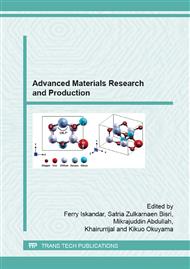p.271
p.275
p.279
p.282
p.286
p.290
p.294
p.299
p.303
First Principle Calculation of Li2Fe0.5Cr0.5SiO4 for Li-Ion Battery Cathode
Abstract:
First principle calculation based on Density Functional Theory and U correction (DFT+U) is used to investigate structural change while losing Li atom, average voltage for couple reaction, phase stability, and electronic structure of Li2Fe0.5Cr0.5SiO4. In this calculation, generalized gradient approach (GGA) of Perdew-Burke-Ernzerhof (PBE) is used for exchange-correlation functional. The initial structure of Li2Fe0.5Cr0.5SiO4 is obtained from the pmn21 structure of Li2FeSiO4 and then the Fe site is substituted by 50 % of Cr. The results of calculation show that the optimized Li2Fe0.5Cr0.5SiO4 has a monoclinic structure, which has little different with Li2FeSiO4 structure. Although the delithiated system (LiFe0.5Cr0.5SiO4) is taken into consideration, the structural geometry does not change significantly. It is indicated that the presence of Cr does not affect to the property of structural change. From the density of states (DOS) analysis, the presence of Cr causes the width of band gap become decrease. Therefore, the electronic properties change from insulator to semiconductor-like behavior. Average voltage for couple reaction M+2/ M+3 of Li2Fe0.5Cr0.5SiO4 is about 3.05 V which is lower than Li2FeSiO4. Furthermore, the formation energy for Li2Fe0.5Cr0.5SiO4 and all delithiation have a relatively positive sign compared with Li2FeSiO4 that mean that they have poor phase stability than Li2FeSiO4.
Info:
Periodical:
Pages:
286-289
Citation:
Online since:
July 2015
Price:
Сopyright:
© 2015 Trans Tech Publications Ltd. All Rights Reserved
Share:
Citation:


